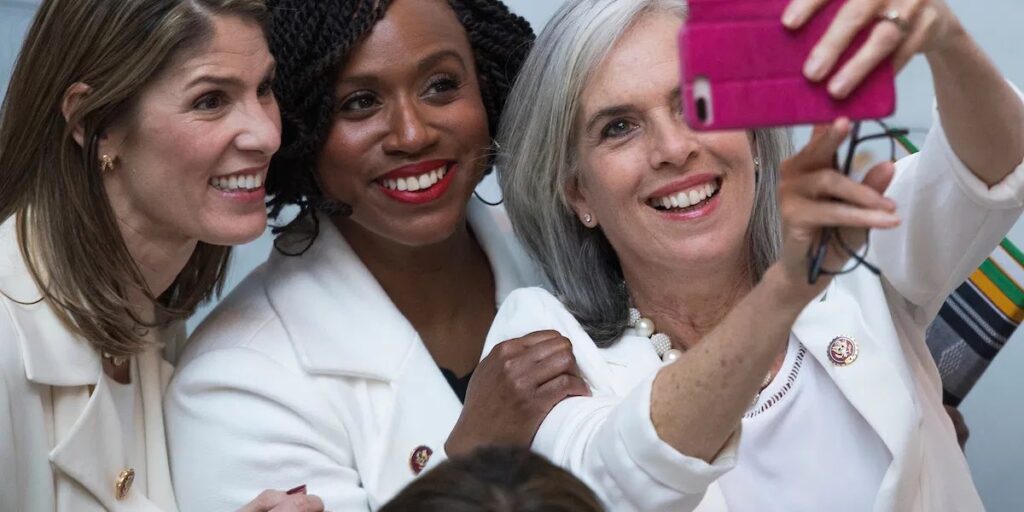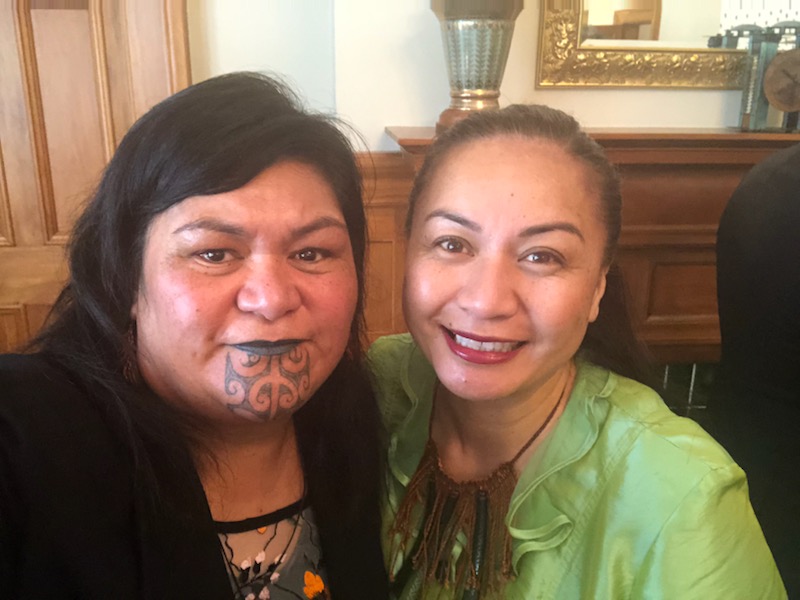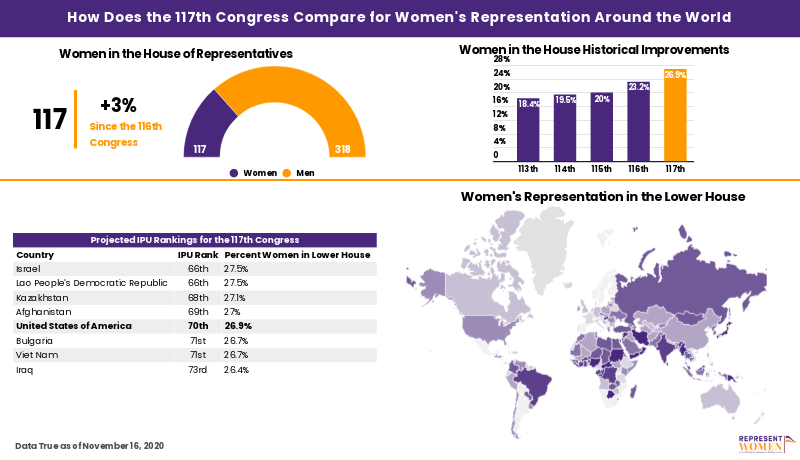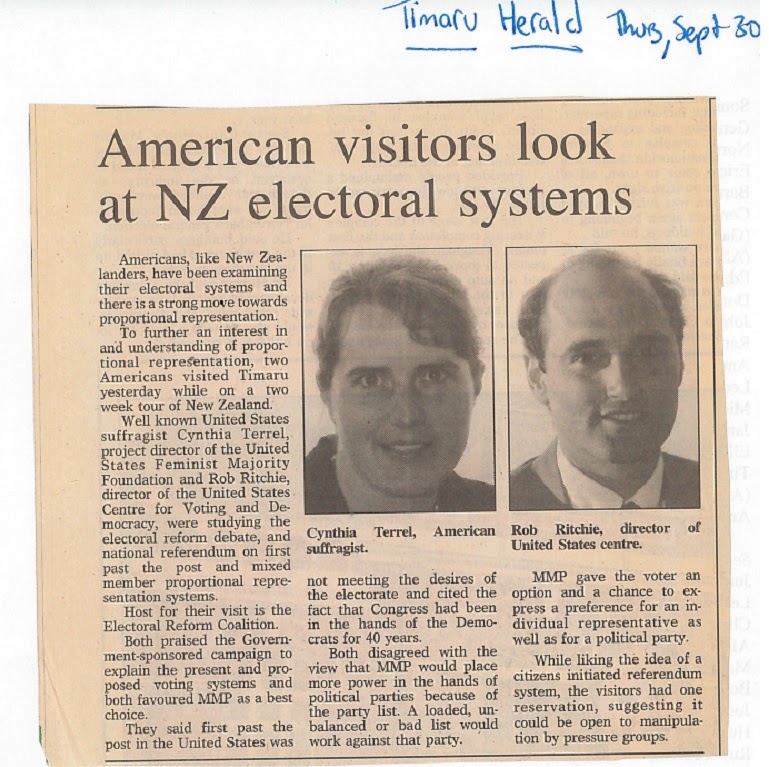Twenty years ago, the U.S. ranked 48th internationally for women’s representation. In 2021, we will rank 70th—that’s a sizable drop. But it doesn’t have to be like this.

While this is technically a “record” breaking year for the numbers of women elected to Congress, women are only guaranteed 141 seats—up slightly from 127 in 2018. And while Republican women made significant gains in the election, only 43 women of color will serve in the 117th Congress.
Progress toward gender balance in politics remains intermittent and uneven across the ideological, racial and geographic spectrum. But don’t just take it from me: The Inter-Parliamentary Union’s ranking of women in parliaments confirms the U.S. is actually not making remarkable progress—in fact, we are falling farther behind our allies in the share of women in Congress.
Twenty years ago, the U.S. ranked 48th internationally for women’s representation. In 2021, we will rank 70th—that’s a sizable drop.
Meanwhile, on the other side of the world, in another former British colony, New Zealand’s recent election has resulted in one of the most diverse governments in the world. Prime Minister Jacinda Ardern led the Labour Party to its first outright victory, winning 64 of the 120 parliamentary seats. The recently elected New Zealand Parliament features the country’s first African, Latin-American and Sri Lankan members of parliament (MPs), 10 percent of the incoming MPs identify as LGBTQ+ including deputy Prime Minister Grant Robertson, and the percent of women held seats increased from 40.8 percent to 47.5 percent—very close to gender parity. The Labour Party alone has surpassed gender parity, with women holding 55 percent of its seats.
Additionally, Ardern nominated the country’s most diverse executive Cabinet to date, including five Maori members, eight women and three LGBTQ+ ministers to the 20 person cabinet.
Appointments include Nanaia Mahuta as the first Indigenous woman foreign minister; in 2016, Mahuta also became the first woman MP to have a moko kauae, a traditional chin tattoo. On the historic nature of her Cabinet, Prime Minister Ardern said, “This is a cabinet and an executive that is based on merit that also happens to be incredibly diverse, and I am proud of that.” Although able to govern with her Labour Party alone, Ardern reached a “cooperation deal” with the Green Party as part of her commitment toward inclusion of different points of view.

New Zealand’s Mixed-Member Proportional Electoral System Means More Diversity in Politics
New Zealand’s successes for women’s representation and overall diversity in politics is not the result of more women and diverse candidates simply running for office—although that helps. Their success results from their mixed-member proportional (MMP) electoral system.
In the MMP system, every eligible voter casts a vote for a political party and a candidate to represent their constituency (or electorate, as it is locally known). Every candidate who wins an electorate receives a seat in Parliament, and the remaining seats are distributed based on the party votes. The party vote determines the number of seats each party gets in Parliament; those seats are filled from the party candidate lists which rank candidates, in order of who will receive a seat first.
Mixed and proportional representation systems correlate with more women and minority candidates winning elections. Political parties have an incentive to appeal to a wider range of voters by including more women and candidates of color on their party lists, and voters may be more likely to vote for a political party rather than an individual woman candidate.
In 2008, Jacinda Ardern herself entered New Zealand politics as the 20th candidate on the Labour Party list, before running for an electorate seat in 2017. The proportional voting system also was key to Ardern becoming prime minister—as the Labour Party finished second in total seats in 2017, but was able to form a governing coalition with two smaller parties.

The U.S.’s “Antiquated” Alternative: Winner Take All—”Built By and For White Men”
Until 1996, New Zealand shared the United States’ antiquated winner takes all electoral system: a system built by and for white men which continues to hinder women’s ability to run and win at equal rates to men.
Following twenty years of disproportionate party seat allocations in the New Zealand Parliament—including the Labour Party winning more votes in 1978 and 1981 but receiving fewer seats than the National Party in Parliament—an independent commission on electoral reform was established in 1984. The commission proposed the replacement of the plurality winner, first-past-the-post system with a German-style mixed member proportional system.
In 1992, the National Party held a non-binding referendum on changing the electoral system: 85 percent voted to change the first-past-the-post system, and 70 percent voted to replace it with a mixed-member proportional system.
In 1993, my husband and I had just helped found FairVote in the United States and were invited to New Zealand by the Electoral Reform Coalition to support and learn about its campaign to win the second and binding referendum.
We toured both the North and South Island, staying in homes of grassroots activists and doing lectures and radio shows. Local articles from the time highlight my interest in the unique nature of the reform’s introduction, through a non-partisan and independent government commission and the subsequent government-sponsored information campaign to explain the present and proposed electoral reform options. Although the campaign was heavily outspent, the referendum ultimately won with 54 percent of the vote.

While I was in New Zealand, women held 21 of the 99 seats in Parliament—roughly 21 percent—while at home in the U.S. after the heralded “Year of the Woman,” women held 47 of the 435 House seats—just under 11 percent.
In 1996, after the first use of their mixed-member proportional system, women won 35 of the 120 parliamentary seats, or 29 percent—an eight percent jump in women’s representation. Meanwhile women in the U.S. House only gained one seat, bringing the total up to 48. New Zealand women have kept winning more seats, and three times have been the nation’s prime minister after an all-male history before the change to MMP.
As we celebrate the fairly meager victories for women candidates in the 2020 election and compare our progress to our democratic allies around the world, there is much to learn from New Zealand’s successful transition to a mixed-member proportional system.
In lieu of a government commission on electoral reform, organizations like RepresentWomen are studying and advancing proven strategies to implement a fairer and more representative electoral system in the United States. We are actively working to build a coalition of stakeholders and allies to update our antiquated voting system which limits competition, favors incumbents, and prevents women’s full and equal political representation.
In order for the United States to make serious and sustained progress toward parity by 2050, we must invest our energy and our resources in systemic reforms that address the structural barriers women face as candidates and elected officials. We hope that others will join us—because equality simply can’t wait.
You may also like:





